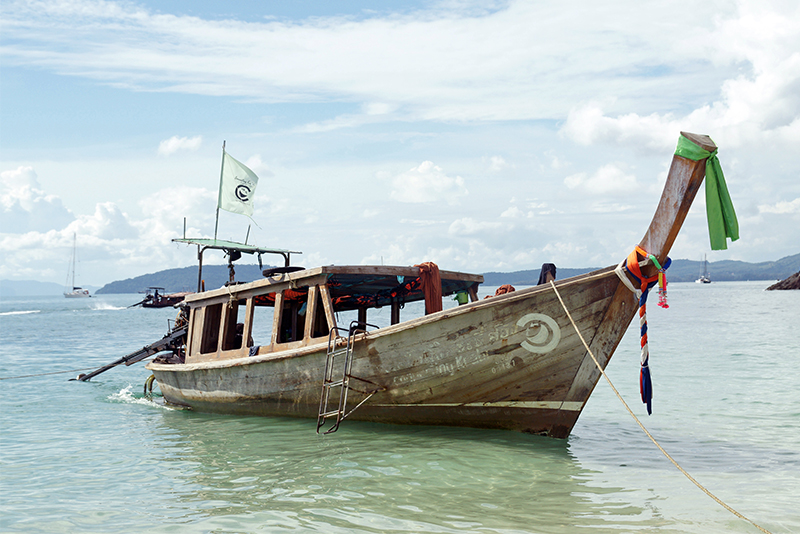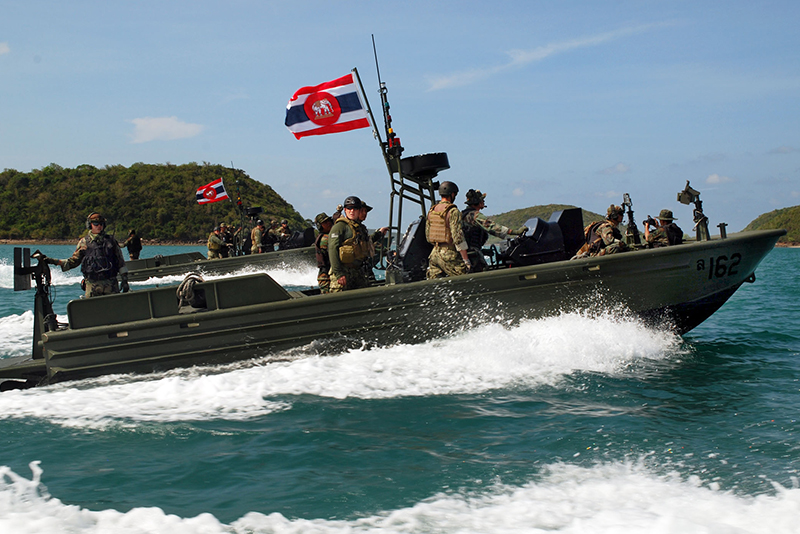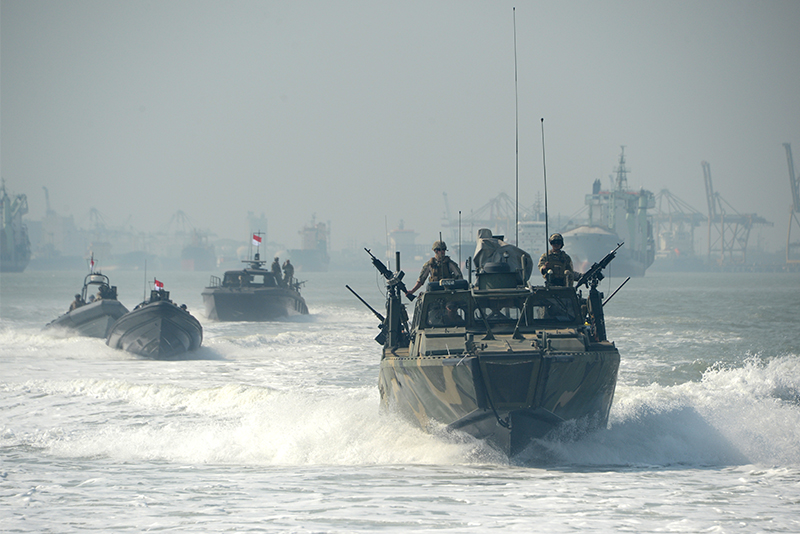
Riverine and inshore patrolling in boats designed with shallow draughts, high speed and that are well armed can fulfill missions from anti-criminal activity to counter-insurgency.
Riverine forces
Riverine forces declined in Asia-Pacific following the end of the European colonial empires until the United States Navy (USN) arrived in Vietnam in the 1960s. Its Mobile Riverine Force was equipped predominantly with the MkI & MkII Patrol Boat, Riverine (PBR) – immortalised in the Hollywood film Apocalypse Now – and the larger Patrol Boat Fast (PBF) also known as Swift Boats for coastal operations and some riverine tasks.
Riverine forces helped maintain contact with local populations and interdict enemy forces by providing access to remote areas through the myriad of rivers and channels.
With the end of the Vietnam war the navy’s riverine force was placed in reserve with some boats retained by, or sold to, Lao, Cambodia, Vietnam and the Philippines as well as other countries such as Brazil, Malta, Panama, Switzerland and Iraq. PCFs still in operation in Thailand, Vietnam and the Philippines are used by Coast Guard and other waterborne forces for local maritime security operations.
It was following the 2003 Iraq War that the USN re-established a new riverine force called RIVRON 1 which deployed in 2007 – the first time it had fielded an active riverine unit since 1975. Placed under the Navy Expeditionary Combat Command (NECC) with 220 sailors and using 12 Small Unit Riverine Craft (SURC) from the US Marine Corp, RIVRON 1 was successful during Operation Iraqi Freedom operating on the River Euphrates and reservoirs of northern Iraq near the Syrian border to counter insurgent activity there.
The SURC are 12 metre-long vessels that can reach a top speed of 40 knots using two HJ292 Hamilton waterjets powered by twin Yanmar 6LY2A-STP 440hp six-cylinder diesel engines. They are designed to transport a 13-man infantry squad and can be fitted with two 7.62mm machine guns on the bow and a .50 calibre gun at stern. These are similar to the PBRs used during Vietnam and the main tasks included the stopping and searching boats on the rivers, searching for hidden weapons stores and engaging in ‘hearts and minds’ operations.
Philippine SURCs
In 2013 the Philippines Marine Corps (PMC) received six SURC vessels from the USN to help the force conduct counter-terrorism operations in riverine and littoral environment in the Mindanao region. At the time it was fighting against the guerrilla Moro National Liberation Front (MNLF) group. A statement by then chief of the Philippine Navy Vice Admiral Jose Luis Alano said that the SURCs would also be used to provide a platform for command and control, reconnaissance, logistic/resupply, medical evacuation, counter-drug operations, humanitarian assistance, peacekeeping and non-combatant evacuation operations. This illustrates the changing operational requirements for riverine craft.
Specialist riverine patrol craft operated by military forces are rare in the Asia-Pacific region. The main inventories use those craft grandfathered in from the US Vietnam-era or purchased or donated from them. Whilst governments in the region are more aware of the value of the exclusive economic zones (EEZs) of their maritime territory there is less concern about the riverine environment.
Myanmar and Thai Patrol crafts
Existing patrol craft are small civilian vessels such as small boats or rubber inflatable craft operated by police and coastal forces. The Myanmar Police Force uses a fleet of 11 Yan Naing- and PCE-class river patrol boats built by the Naval Dockyard in Yangon that have been in-service since about 2013. But navies are more focussed on the offshore or blue water environment and funding is devoted to larger ships as a result.
The Royal Thai Navy (RTN) has a riverine patrol regiment that operates in the upper Mekong and Chao Phraya rivers to combat illegal activities in the area. The regiment owns boats that are small GRP-hull vessels with a basic sensor and a crew-served twin .50cal embedded in the bow.
Despite or perhaps because of their lack of resources, Thailand and Myanmar announced in January 2018 that the countries would cooperate on border security along the Moei River on Thailand’s north-west border. This is an effort to limit labour and drug trafficking but soldiers are restricted to using four wooden long-tail boats.

NECC RIVRON
To bolster skills and experience the USN’s Expeditionary Combat Command (NECC) RIVRON units trained with the Thai riverine patrol regiment for the first time during Cooperation Afloat Readiness and Training (CARAT) in 2010 using RIVRON’s SURC and SOC-R craft. CARAT exercises are an annual, bilateral exercise series with the USN, US Marine Corps (USMC) and the armed forces of nine partner nations including: Bangladesh, Brunei, Cambodia, Indonesia, Malaysia, the Philippines, Singapore, Thailand and Timor-Leste.

But following the end of Operation Iraqi Freedom at the end of 2011, the NECC’s RIVRON units were merged into the new Coastal Riverine Force (CRF). Requirements have changed and a specific riverine capability is not something that needs to be sustained as a permanent naval asset. A spokesperson for the NECC told AMR that the riverine mission capability “is no longer a mission of the CRF” and added that “the CRF mission now supports maritime security exclusively. The CRF mission is to defend designated high value assets against a determined enemy and, when ordered, conduct offensive combat operations to dominate the littorals and reinforce the blue water operations.”
However, the CRFs have introduced the new 85ft Mark VI Patrol Boat built by SafeBoats International for the coastal role and 12 were delivered from 2016-18. Worth about $8.6 million per platform with another $6 million on each of the boat’s equipment these have replaced the 53ft River Command Boats (RCBs) that were based on the Swedish Combat Boat 90 (CB90) craft.
The capabilities of the new Mark VI Patrol Boat are suited to littoral operations and their presence in the Asia-Pacific is from the CRF base in Guam. The boats are fitted with waterjets and twin MTU 16V 2000 M94 diesel engines providing a top speed of 40kts and a range of 500 miles (800km). The boats have space for 10 crew and accommodation for 20 personnel which is more than the 4-8 crew and space for 15 personnel on the RCBs. They are fitted with two stabilised remote-operated optically guided Mk50 Mod 0 .50 cal gun systems, two stabilised remote-operated Mk38 Mod 2 25mm gun systems with optical guidance and two crew-served .50 cal machine guns. There is also space for mountings that can fit the Mk19 40mm grenade launcher, miniguns, 7.62mm and 5.56mm machine guns.
The NECC spokesperson said the craft has “demonstrated the capability of sustaining a firefight for 45 minutes”, which is a considerable step up in firepower from earlier boats like PBR, PBF or SURC.
The CRF is organised into two groups with seven squadrons and 31 Coastal Riverine Companies. One group is in San Diego (CRG-1) on the west coast where Squadrons 1, 3 and 11 are home ported and one in Virginia Beach (CRG-2) where squadrons 2, 4, 8 and 10 are home ported on the east coast. The group each provide a Coastal Riverine Squadron for two forward deployed expeditionary security detachments based in Guam and Bahrain.
The CRFs also has an inventory of 100-160 25ft boats from SafeBoats International and 34ft boats from SeaArk Marine. The next CRF acquisition priority is to replace the 34ft SeaArks with a new 40ft patrol boat in 2020.
Metal Shark Boats is providing its PB-X vessel following a $90.27 million contract awarded by NAVSEA in October 2017 that includes spares, trailers and support. An initial 11 craft will be delivered by 2020 with up to 50 expected that will be delivered over the next 15 years. With a draft of 3ft the boat can access shallower waters in the littoral with space for a crew of 5-9 personnel. It can be fitted with .50 cal machine guns and long-range acoustic devices (LRAD) but also has space for Mk18 Mod 1 and Mod 2 mine countermeasures underwater vehicles. It can be expected these will be deployed to the Asia-Pacific region with the forward deployed CRF Squadrons at Guam in due course.
SOF Riverine Capability
Meanwhile a dedicated US riverine capability is solely the preserve of US Special Operations Forces (SOF), which use the Special Operations Craft – Riverine (SOC-R). Manufactured by United States Marine (USMI). The SOC-R is designed to be air transportable and air dropped for insertion and extraction of Navy SEAL teams well inland and up rivers. It has high speed and shallow draft able to beach on mud and riverbanks in water only 2ft deep. These have replaced the 31ft PBRs and are significantly more capable fitted with a full communications suite, sensors including radar, electro-optical systems, and radios with long-life batteries for long duration missions. Armaments include 7.62mm and .50 cal machine guns, 40mm grenade launchers and miniguns. US SOF operate globally and are likely to deploy to the Asia-Pacific region should a crisis arise.
The special forces relationship is a valuable one. During CARAT 2015 in Indonesia, the Coastal Riverine Squadron trained with the Indonesian Kopaska naval special force, which operate small fast boats such as the Avon Sea Rider RHIB and X38 Combat Boat that are capable for riverine operations. The X38 is a 12.4m-long catamaran built by PT Lundin that can achieve a top speed of 40kts and at the IndoDefence exhibition in 2016 the company launched a new X18 Tank Boat prototype fitted with the CMI 3105 105mm light gun.

The X18 is 40 tonne craft designed to be used for littoral operations as riverine craft but also to provide support to amphibious landings and offer an overmatch in firepower in operations on waterways and in very shallow water. It can also be used as a troop transport with space for 20 personnel. A launch customer was expected in the Middle East and it is unclear if the Indonesian Navy or Kopaska have any interest.
Meanwhile one other country with specialist riverine craft is Malaysia where the CB90 is still in-service with the Royal Malaysian Navy (RMN). It bought 17 platforms that include five standard CB90 and 12 CB90HEX variants that were delivered by Swedish shipbuilder Dockstavarvet from 1996-2001. Now owned by Saab, the company said that about 250 boats have been exported worldwide since the 1990s for a variety of coastal and riverine operations. The Malaysian marine police also use the IC16 boat, which has a different placement of the wheelhouse compared to the CB90.
Similar geography
Jorgen Olsson, senior sales executive at Saab Kockums told AMR that the operational requirements in the Asia-Pacific region are similar to those in Sweden: “If we look at several countries in the region: Korea, Indonesia, Thailand, Malaysia; they are archipelagos similar to the Sweden with the same geography, shallow, narrow waters, a green or grey/brown water environment where the performance of the boat requires a very shallow draught with high performance and speed.”
Malaysia has issues with illegal fishing and drug trafficking therefore a low-profile boats with high speed and good manoeuvrability that can transport cargo and troops is needed, especially for intercepting, catching criminals and taking them into custody. The CB90s have been primarily used in East Malaysia on the island of Borneo for patrol and surveillance in the provinces of Sarawak and Sabah.
The RMN is now looking to acquire more riverine and coastal craft and has a new project to buy up to 18 Fast Interceptor Craft (FIC) as part of its 15-to-5 transformation plan. A tender has yet to be released by requirements have been released to local shipbuilders for consultation.
Malaysian shipbuilders might have first preference for the FIC however as the police have taken delivery of 10 M16 fast strike craft from local builders Geliga Slipway and the Malaysian Coast Guard taken two Penggalang interceptors from Destini Shipbuilding and 10 Onuk MRTP16 interceptors from BYO Marine.
“There is ongoing FIC programme in Malaysia that we have under evaluation. It is one identified opportunity and as we have an installed base in-country it is of interest to us,” Olsson said.

In October 2019, Saab launched a new updated variant of the CB90 called the CB90HSM and has delivered the first of 18 boats to the Royal Swedish Navy (RSwN). Olsson said that there was a requirement for new capabilities for more cargo, ballistic protection and larger weapons including a Remote Weapon Station and the ability to achieve a top speed of 45kts with two new 900hp Scania Diesel V8 engines and S32 waterjets.
Displacing 24.5t and measuring 16.3m, CB90 HSM has a draught of just a third of a metre and uses the same hull design as the earlier CB90 variant. “From the outside the HSM still looks the same but we have really got higher manoeuvrability and speed and the possibility to carry a heavier load,” Olsson said. CB90 HSM is fitted with the Trackfire system that provides weapon stabilisation and increase surveillance and targeting with electro-optical and infra-red cameras.
Military riverine operations have been downgraded and forces are focussed on the wider littoral and coastal areas with the platforms being used for patrolling also changing as a result, getting larger, faster and with more sensors, firepower and cargo capacity. Only a few countries in the Asia-Pacific region can afford dedicated patrol craft for their military forces that can cater for all these missions and until governments recognise the importance of riverine security it is unlikely that major investment in new craft will follow.
by Tim Fish












